One of the most anticipated sets each year is the newest addition to the LEGO Creator Modular Buildings line. 2017 is particularly significant, as it marks the 10-year anniversary of this highly popular series. The #10255 LEGO Creator Assembly Square is a beautiful set in its own right, while also referencing many of the previous LEGO Modular Buildings. The set became available a couple of days ago, so let’s take a closer look. 🙂

Since this is a 10-year anniversary set, I thought it would be a good idea to do a bit of an overview of the history of the LEGO Modular Buildings. According to Wikipedia, in 2006 LEGO polled the adult fan community, asking for some ideas for future product lines. Some of the ideas submitted were having more town and everyday buildings with enclosed walls, a realistic scale, and more detailed architectural elements.

These ideas were taken into consideration, and thus in 2007 the first LEGO Modular Building was born; the #10182 LEGO Modular Café Corner (2056 pieces, price $139.99). LEGO continued to work closely with the LEGO fan community on this new line, and the same year the #10190 LEGO Modular Market Street (1248 pieces, price $89.99) was also released. This set was designed by Dutch LEGO fan Eric Brok to match the style of the Café Corner but with fewer pieces and a more affordable price. In 2008 the #10185 LEGO Modular Green Grocer (2352 pieces, price $149.99) was added, and this is when the LEGO fan community really started to take notice and began collecting the sets. In 2009 the #10197 LEGO Modular Fire Brigade (2231 pieces, price $149.99) was released, followed by the #10211 LEGO Modular Grand Emporium (2182 pieces, price $149.99) in 2010. The #10218 LEGO Modular Pet Shop (2032 pieces, price $149.99) released in 2011, broke the trend with its split design, which made it the most versatile and thus longest standing set to date. 2012 saw another trend-breaker in the #10224 LEGO Modular Town Hall (2766 pieces, price $199.99) as the largest set in both piece count and price to that date. Then LEGO went back to more standard sets in the form of the #10232 LEGO Modular Palace Cinema (2196 pieces, price $149.99) in 2013, the #10243 LEGO Modular Parisian Restaurant (2469 pieces, price $159.99) in 2014, and the #10246 LEGO Modular Detective’s Office (2262 pieces, price $159.99) in 2015, and the #10251 LEGO Modular Brick Bank (2380 pieces, price $169.99) in 2016. Note the higher piece-count and the slightly higher price of the sets starting with the Parisian Restaurant. This is because the interior of the sets started to get significantly more detailed with tiled floors and more accessories. And now, to celebrate 10 glorious years, in 2017 LEGO released the largest LEGO Modular building of all; the #10255 LEGO Modular Assembly Square (4002 pieces, price $279.99). In the video below you can see Jamie Berard, lead designer for the LEGO Creator line, introduce the set.
Here is the official description of the #10255 LEGO Modular Assembly Square: Take a trip to the amazing Assembly Square, developed to celebrate ten years of LEGO Modular Buildings, featuring a wealth of unsurpassed, intricate details and hidden surprises. Easy-to-remove building sections provide access to the highly detailed interior, comprising a ground level with a bakery, florist’s shop and café, a middle level with a music store, photo studio and dental office, and an upper-level dance studio and apartment with access to a rooftop terrace with barbecue. The exterior of the building features a detailed sidewalk with outdoor café furniture, fountain, streetlamps and a highly elaborate facade with beautifully detailed windows and doors, three buildable shop signs, spired tower and a decorative roofline. Includes eight minifigures: a dentist, barista, baker, florist, music store assistant, dancer, photographer and a LEGO fan, plus a baby figure. Measures over 13” (35cm) high, 14” (38cm) wide and 9” (25cm) deep. 4002 pieces. Price: $279.99 – BUY HERE


As there is so much to talk about, I thought to break down this review in the way you build them by bag numbers. There are six sets of numbered bags, so we will discuss each of those sections separately. I would also note here that each of those sections takes about one and a half hours to build, with a total building time of about nine hours. So, if you plan to build this set, make sure you give yourself enough time, and take some breaks in between building the sections. The building experience is never boring, because there are so many interesting details, but still, to sit through nine hours of building can be tough even for dedicated LEGO fans.

The very first thing you will notice about this set when you see it on store shelves (or you receive it by mail) that the box is unusually large – about twice the size of the previous LEGO Modular Buildings. Inside the outer box, there is another large plain white box, which contains all the bags numbered 1-3. The rest of the bags sit loosely in the box, along with the two baseplates. The instruction book is also very large, 300 pages long and comes in its own bag (I weighted the booklet just for fun – it is 1 pound 6 ounces!)

➡ LEGO ASSEMBLY SQUARE – BAGS #1 (3 numbered bags): In this section you join together the two baseplates (32×32 stud and 16×32 stud), and build the three pretty tile patterns in the courtyard, as well as the first floor patterns of each of the three buildings. You are basically just doing tiling, however it is not boring at all, as you are building a number of very pretty mosaic designs with a lot of those interesting new corner tile pieces (as well as regular tiles in different sizes). The mosaic around the fountain is particularly beautiful, and you can tell that nothing was spared to make it a gorgeous centerpiece. My only complaint about this section is that the two baseplates are only connected at eight points, so if you build on a not-so-solid surface (like me; I’m a floor builder) they will keep falling apart. The baseplates won’t get solidly joined until much later in the build. So if you can, choose a solid surface to build on. You also build the baby carriage in this section, which is quite similar to the one that was included in the #10185 LEGO Creator Green Grocer. Noteworthy parts in this section are all the tiles. You get a very large number of 1×1, 1×2, 1×3, 1×4, 1×6, 1×8, 2×2, 2×4 tiles, and 2×2 corner tiles in a number of colors, and the new 2×2 corner tile with 45° angle in four colors; white (12 pieces), light-bluish-gray (7 pieces), dark-bluish-gray (18 pieces), and dark-blue (4 pieces). There are also some new curved tiles, but they will come up later in the build.
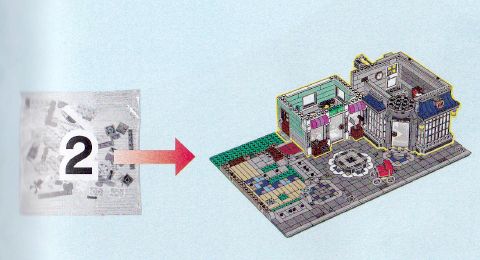
➡ LEGO ASSEMBLY SQUARE – BAGS #2 (7 numbered bags): In this section you build the first floor of the bakery and the flower shop. This section takes the longest time to build because of all the details in both of the shops, but it is also the most fun. The flower arrangements are so lovely, and building all those fancy cakes made me so hungry! No details are spared in either of the shops. It is worth noting that the blue and yellow parrot in the flower shop is not just a new color, but a new mould with slightly different head and other details. I’m not sure what was the reason for the update. I don’t like how the yellow and blue color blends so randomly – no parrot I have ever seen is colored like that. While the new mould is fine, I much prefer the printed or blended colors of the old parrots, as they are much more realistic. In fact, I already replaced mine with a red and green parrot I had from a previous set.

While the bakery is very lovely, it is not nearly as well equipped and logically laid out as the kitchen in the #10243 LEGO Creator Parisian Restaurant. That kitchen has everything you need to run a restaurant; pots, pans, sink, stove, oven, food prep area, sink, fridge, etc. The bakery would be fine if it would only sell pastries, as you could imagine they are prepared somewhere else and this was just their retail store. However LEGO threw in an oven, indicating that everything is freshly made, but there is no area where things are prepared. If you want to be more realistic, you would either need to take out the oven, or put in at least some bakery equipment to make the cookies and cakes (perhaps from LEGO Friends sets, which have excellent bakeries).
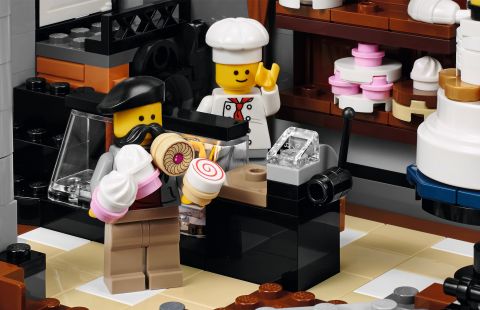
One of the highlighted features of this section of the build is the bakery windows made of garage-door panels. It is actually a pretty challenging build as you need to line up and connect everything perfectly, but the idea is ingenious. Unfortunately, the end result is not the most appropriate for a bakery, as you can barely see through the thick panels. They sort of have a fenced window effect – the kind you see at pawn shops, gun shops, and stores in shady neighborhoods. Of course, we know that the hidden story behind the LEGO Modular Buildings is the cookie-smuggling operation, so perhaps minifigs take their cookies so seriously that they need extra protection. Also, it is ironic that while the bakery uses a pretzel sign over the window, there are no pretzels sold at the store.
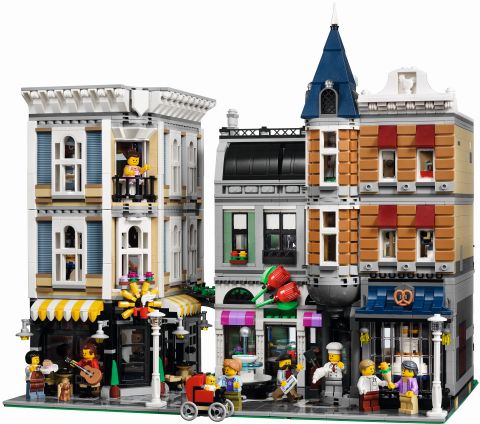
Another feature of this section that is a bit perturbing is the clock in the bakery shows it is eight minutes to noon. This is a new clock (first appeared in the #71040 LEGO Disney Castle), printed on a 2×2 round tile. Because it has printed numbers, the clock can only be displayed in one way, and you have to adjust all your other clocks to it. The other LEGO Modular Buildings all use the standard white clock with no numbers, so they can be set in different ways. Unfortunately in no configuration do they look like 8 minutes to noon. The closest you can get them is 18 minutes to noon. Then there is another clock in the tower of the #10224 LEGO Creator Town Hall. This clock also has no numerals so you can set it in different ways, but the closest you can get to the setting of the bakery’s clock is 16 minutes after noon. So now you have three different times in your LEGO city, which will certainly result in missed appointments and confusion.

Noteworthy parts in this section are the sand-green pieces in the flower shop, the new corner door in the bakery, and all the cookies and cake making pieces (none are new, but they are still fun). The wedding cake in the window is a particularly interesting build, so are the two lights at the front of the bakery window. I also really like the techniques used for building the bottom of the spired tower above the entrance of the bakery.
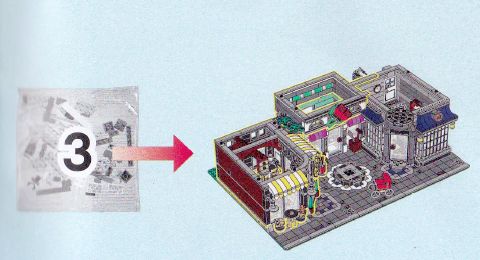
➡ LEGO ASSEMBLY SQUARE – BAGS #3 (5 numbered bags): In this section you start working on the third building, and put in the café shop. You also finish building the walls of the flower shop, and the sign in front of the flower shop. The café shop is an obvious reference to the #10182 LEGO Creator Café Corner with its corner door, spiky decoration over the door, and white and yellow awnings. The design of the interior and exterior seating is very nice, heavily depending on the new 1×1 curved corner tile elements. There is also a little station to prepare cafe and serve pies.
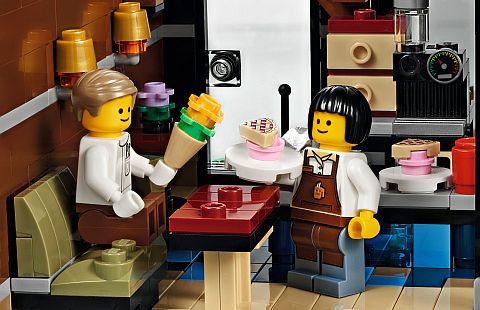
All three buildings have fairly tall first floors, but while the bakery and the café shop are large enough for adults to reach in, the flower shop has a smaller footprint. To help grown-up LEGO fans to play inside, the upper section of the back wall of the flower shop is attached only by two studs and can be removed easily – a very thoughtful feature. The sign of the flower shop made up of two brick-built red flowers looks lovely. It also brightens up the building (along with the dark-pink/lavender awnings), that could otherwise easily get lost as it sits much further back compared to the other buildings.

In this section you also join the café shop and the flower shop with a wrought iron awning with some vines growing over it. I quite like this little feature that is similar to the walkway in the #10246 LEGO Creator Detective’s Office, and gives minifigs access to the alleyway behind the buildings. Noteworthy parts in this section are the 1×1 round quarter tiles in tan, black and with a pie-print, the 1×1 round plates with hole in the middle in translucent orange (used as lights inside the café shop), and the large curved tile above the door (you get four of these in total). Also, it is interesting that the bakery, the flower shop, the café shop and the music store all have cash registers, and they are all built differently.

➡ LEGO ASSEMBLY SQUARE – BAGS #4 (5 numbered bags): In this section you build the second floor above the bakery and the flower shop. Over the bakery is the dentist’s office, and over the flower shop is the photo studio. The dentist’s office is a very fun build, especially the chair, the lamp, and all the dental tools around. The light aqua color is just perfect for this application. There is not much else in the dentist’s office besides some cabinets and a little waiting area. A number of reviewers pointed out that they find it strange that there is no wall between the two sections, so minifigs have full view of the dentist torturing patients. With three doors in the waiting area to escape, I’m not sure how many patients this dentist can actually keep. There is also some very humorous parts to the dentist’s office, but I’m not going to spoil it for you.

The photo studio is pretty simple, but comes with two brilliantly built details; the backdrop and the old fashioned camera. The camera, in particular, is a wonderfully designed device, and I’m surprised how well the legs work to lock into the floor, while still remaining easily removable.

Noteworthy parts in this section are the smaller curved tiles, the white windowpanes in the photo studio (to keep light out), the new 1×1 tan bricks with studs on two adjacent sides (you get 19 of them), the 1×2 tan bricks with two studs on top and two on the side (you get 73 of them), the printed windowpane for the dentist’s office, and the dentist’s printed torso. Also, you get a large number of 1×2 tiles (49 in total) and 1×1 cheese-slopes (60 in total) in medium-nougat (medium-dark-flesh on BrickLink).

➡ LEGO ASSEMBLY SQUARE – BAGS #5 (6 numbered bags): In this section you complete the sand-blue and white building by finishing the second and third floors as well as the roof. The two floors are almost identical, and you can use them interchangeably, if you want to. The second floor houses a music store, and the third floor a dance studio. They are fairly plain with not much in them, so these are the sections you can definitely build up with your own ideas.

However, there are still some very nice building techniques that you can find here. I particularly like the construction of the windows. They are the same as in the apartment side of the #10218 LEGO Creator Pet Shop. They are quite substantial and look good. I just hope that one day LEGO will finally make a windowpane for the arched window frames. The piano is a beautifully detailed musical instrument using some complex building techniques. Definitely one of the highlights of the entire set.

The walls on both floors are sand-blue, so you get a lot of regular sand-blue bricks as well as the textured ones with the horizontal grilles on one side, and vertical grilles on the other. While officially all the grilles are placed horizontally in the set, you can play with them to work out your own pattern.

As far as noteworthy parts, a ridiculous amount of 1×1 half circle tiles (often referred to as tooth tiles or fingernail tiles) are used to create some decorations (you get 46 in total), which you hardly even notice once the set is put together (just like all the LEGO Modular Buildings, this set is a fantastic parts-pack).

You also get 25 white 1×1 bricks with the scroll decoration, which are used for the roof. The mirror element used in the dance studio is the same as in the barber shop side of the #10246 LEGO Creator Detective’s Office. This time however it is simply placed in a small ziplock bag, instead of being covered with a white film. I think way too many people thought their mirror was defective in the previous set, not knowing that the film had to be removed.

➡ LEGO ASSEMBLY SQUARE – BAGS #6 (7 numbered bags): While these are the last bags, we are not close to being finished yet, as LEGO kept the best for last! In this section you build the third floor apartment and roof for the bakery building, the rooftop terrace and roof above the flower shop building, the fountain in the courtyard and two streetlamps.

The apartment on the third floor of the bakery building, and the terrace of the flower shop building are on the same level, so they are built at the same time. The apartment belongs to a typical LEGO fan with most of the space taken up by LEGO displays. There is an extensive LEGO train layout on a table with a micro version of the #10233 LEGO Horizon Express. On a shelf close to the door there is a micro version of the #10220 LEGO Volkswagen T1 Camper Van and the #10242 LEGO MINI Cooper. There is also another display above the sofa bed with the three original LEGO Modular Buildings; the #10182 LEGO Café Corner, the #10190 LEGO Market Street, and the #10185 LEGO Green Grocer. LEGO designer Jamie Berard must have had a lot of fun with these! Oh, and in the little tower section of the apartment you will find a micro version of the #10181 LEGO Eiffel Tower. LEGO fans occasionally need to eat, sleep and go the bathroom too, so there is a small kitchen included, a toilet (with water in the toilet bowl!), and a sofa that can be converted into a bed. Oh, and I almost forgot the mention the 2×3 printed tile with the #10182 LEGO Café Corner printed on it to look like a LEGO box. So sweet!



The apartment’s door leads to the very spacious and cozy rooftop terrace with a nice grill and seating area for two. It also has a neglected plant, which is funny – LEGO fans are usually not very good at taking care of plants. The roof of the flower shop building is made of LEGO Technic excavator scoops. I was a little afraid that these will be too obvious, but they actually blend in better than I thought they would.

The last thing you put together to finish off the structures is the roof and tower of the bakery building. I really like the building techniques used for the white decorative roofline, and that dark-blue tower capping off the spired tower of the first and second floors is so handsome. For the last part of the build, we go back to street level to finish the water fountain, and build a couple of standard streetlamps. And we are done! Below I have included a build-review of the set by Artifex Creation, so you can see the details better.
The whole LEGO Creator Assembly Square is half a baseplate (16 studs) wider than all previous LEGO Modular Buildings, so it is a much larger set, however the three buildings are all quite narrow (the bakery and the café shop are 14 studs wide each, and the flower shop is 16 studs wide), so they fit right in with all the other sets. The bakery building is the same height (minus the tower and decorative roofline) as the #10218 LEGO Creator Pet Shop, and the sand-blue café shop building is the same height as the blue building in the #10246 LEGO Creator Detective’s Office.

I don’t know if you have noticed this, but there are so many doors! In fact, the three buildings are all an interconnected maze of doors and stairways. For example, if you want to go to the dentist, you have to either walk through the bakery or the flower shop (I forgot to mention that there is an open walkway between the two), then walk out a back door, walk up a staircase, and you are in a waiting room that can lead either to the dentist or the photo studio. If you want to visit the LEGO fan’s apartment on top, there is another door in the waiting room that will take you to a staircase that will take you to another door. It’s really fun. Unfortunately my setup is against a wall, so I can’t really see the back of the buildings, but they are just as well developed (although less decorative) than the fronts.

I’m not going to talk about the minifigures too much as they are mostly just regular guys and gals with the exception of the dentist who has a unique torso print. I would mention though that the minifigs are spread out between the sets of bags, so in each section you will get one or two. They all come with the classic LEGO smiley faces.

As I mentioned at the beginning, the connection between the two baseplates was quite flimsy during a good part of the building process, so I was worried that the set will be difficult to pick up without it splitting apart at the seam. But at some point in the building process everything got securely locked in, and the set is easy to move around with no worries.

Throughout the building experience I was either absorbed in building all the pretty details, admiring the beautiful colors, or elated by the parts selection. It was one pleasant surprise after another for a solid nine hours. This set is definitely a LEGO fan’s dream. And after all that time building, the end result looks gorgeous – even better than I expected. I know that this set is expensive compared to the regular LEGO Modular Buildings, but if there is any chance you can get it, don’t hesitate to pick it up. You won’t regret it. And if you can, get a second one too, just for the parts. It is available now under the LEGO Creator section of the Online LEGO Shop.

What do you think? How do you like the LEGO Creator Assembly Square? Are you planning to get it? Or do you have it already? Feel free to share your own thoughts and review in the comment section below! 😉
And you might also like to check out the following related posts:
- LEGO Creator Assembly Square Press-Release
- LEGO Creator Assembly Square Customization
- LEGO Creator Brick Bank Full Review
- LEGO Detective’s Office Review & Thoughts
- LEGO Parisian Restaurant Walk-Thru Review
- The Little Brother of LEGO Modular Buildings
- How to Expand the LEGO Modular Buildings
- LEGO Modular Buildings Alternate Colors





























